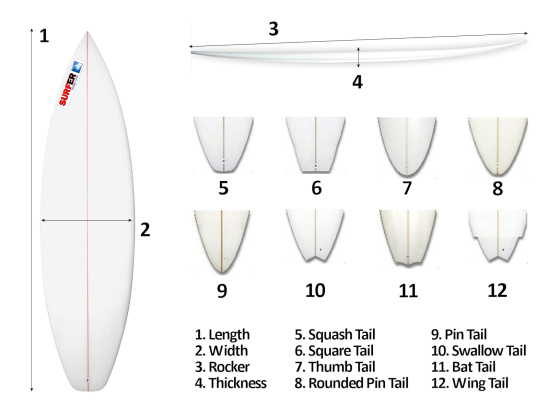Surfboard design is all about fluid dynamics, not color, look, or style. When you're buying a surfboard, you're choosing the plank that will suit you best. You're interested in getting the best surfboard for your level of experience and/or for a determined type of wave.
The flow of water is the science behind surfboard shaping and manufacturing. When shapers design their models, they know exactly what they're doing.
There are several variables in the creation of a good surfboard model.
Surfers should take note of the type of blank that is used, the quality of the fiberglass and resins, the knowledge of the shaper, and more.
Surfboard design also involves the outline. The overall design of the board has a profound impact on the wave riding performance.
A rounder template will force a surfer to cut longer curves and surf with a more laid-back style than a pointier one will allow for.
Width and Length
Width and length are also very important details. Typically, you have between 18'' and 24" of width to choose from.
Wider boards offer more fluctuation and are the perfect choice for very small, fat waves.
With narrower surfboards, you can test your take-off skills in deep, hollow waves.
If you have trouble catching waves, you will probably need a longer surfboard.
But remember that you'll find it harder to turn than if you were surfing with a shorter board.
Thickness
Surfboard thickness is also relevant in wave riding performance.
Normally, the thickness point is in the middle area of the surfboard, but in some cases, the thickness can be held through the tail and rocker.
When this is the case - when the thickness level is almost even throughout - it allows stability on a wave.
Surfers experience greater balance over both feet as they change positions throughout the ride.
A well-distributed surfboard thickness helps maintain control despite constant weight changes on the blank.
Rocker
The rocker is considered by many shapers the most important feature of a surfboard.
When viewed from the side, the rocker is the curve of the surfboard from tail to nose. The surfboard rocker is subdivided into nose rocker, center, and tail rocker.
When it comes to analyzing surfboard rockers, there are a few logical rules.
The more rocker a surfboard has, the looser and slower it will be.
Plain and flat rockers deliver faster wave performance, although surfing maneuvers are harder to pull.
A flat rocker works very well on small wave boards.
Bottom Contour
Surfboard bottom contours are also essential.
Concave and V-shaped contours have similar performances despite opposite designs.
A concave surface - or channel-type contour - will help your tail respond faster and more easily to rapid turns.
The Vee model helps you carve.
A flat contour is difficult to control at high speed.
Tail Shape
Tail designs are a hotly-discussed topic in modern surfboard shaping.
The tapered pintail is a great design for big waves because there is less board in contact with the water, and more speed is achieved.
The rounded pintail, round tail, squash tail, and rounded tail are all very common because they hold the surfboard quite well in all-around surf conditions.
The squash tail sits in the middle term.
Sharper edges, like the square tail, are more responsive to rad turns.
Swallowtails help your paddling power and are easier to control in small waves.
Fins and Setups
Surfboard fins are part of the entire hydrodynamic performance but are an external feature.
Learn more about the importance of fin setups (single fin, twin fin, thruster, and quad).
Learn how to shape a surfboard.
